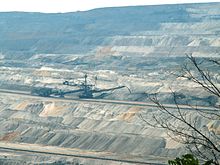Weaners


A spreader is a device for the continuous targeted deposition of bulk material . The device is mostly used in open-cast mining or in flat storage facilities.
Structure and differentiation
A spreader consists of a chassis, a rotating superstructure with a discharge boom and a feed for the material to be tipped, which in the case of large devices can be designed as a self-propelled tripper car, sometimes also with a self-propelled intermediate conveyor.
Depending on how the material is fed, a distinction can be made between:
- Spreaders for train operation
- Spreaders for belt operation
Another possibility of classification results from the chassis:
- Spreaders with crawler tracks
- Spreader with walking mechanism
- Spreaders with rail chassis
Use in Germany
In Germany, spreaders are used as open-cast mining equipment for tipping overburden or other materials that arise during the extraction or processing of lignite . Spreaders for belt operation are mainly used. These often work together with a tripper car . The tripper car transfers the overburden coming from the conveyor belt to the stacker. The spreader can fill the opencast mine again with its long, swiveling boom.
But stackers for train operations are still in use. In these, the material is first tipped by the train into a small bunker and then picked up again by the grave organ ( bucket chain ) of the skip. The masses are then tilted at the desired point. This technology is used, for example, in some open-cast mines in the Lusatian lignite mining district . In the Jänschwalde open-cast mine, for example, products from the flue gas desulphurisation (gypsum) from the Jänschwalde power plant are temporarily stored on a specially constructed high dump .
Up until the reunification , the power plant ashes were mixed in on an outside dump above the spoil masses of the spoil pile dumped by the spoil conveyor bridge F60 to improve the soil. Mixing in the power plant ash is no longer permissible from today's environmental point of view. The reason for this is the electrical conductivity , which is above the permissible limit value. The power plant ash must no longer come into contact with the groundwater . Therefore, high tipping is now being created and then sealed.
literature
- Б. В. Бокий: mining science . Technology, Berlin 1955, p. 490–495 (Russian: Горное Дело . Translated by Dr. R. Staepken).
Web links
- Opencast mining technology: stacker. In: World of Technology. Archived from the original on May 11, 2009 ; accessed on October 17, 2015 .

